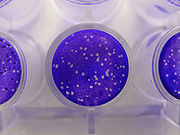Portal:Viruses/Selected miscellany/7
Virus quantification is necessary for viral vaccine production, and is used to manage people infected with HIV, hepatitis B and C, and cytomegalovirus. A wide range of traditional and modern methods are used. Plaque assays (pictured) infect a monolayer of host cells with dilutions of the virus and count the number of holes or plaques, where cells have lysed and infected their neighbours. For viruses that do not lyse their host cell, plaques of cells showing cytopathic effects can be counted or viral proteins can be immunostained with fluorescent-labelled antibodies. These methods quantify infectious virus, while others, such as electron microscopy, return a higher concentration because they count all virus particles, whether or not they are viable. Other assays, such as the haemagglutinin assay, quantify viral proteins.
Often slow and labour intensive, traditional methods have been complemented by modern technologies that greatly reduce quantification time, including quantitative polymerase chain reaction, flow cytometry, enzyme-linked immunosorbent assays and tunable resistive pulse sensing.

